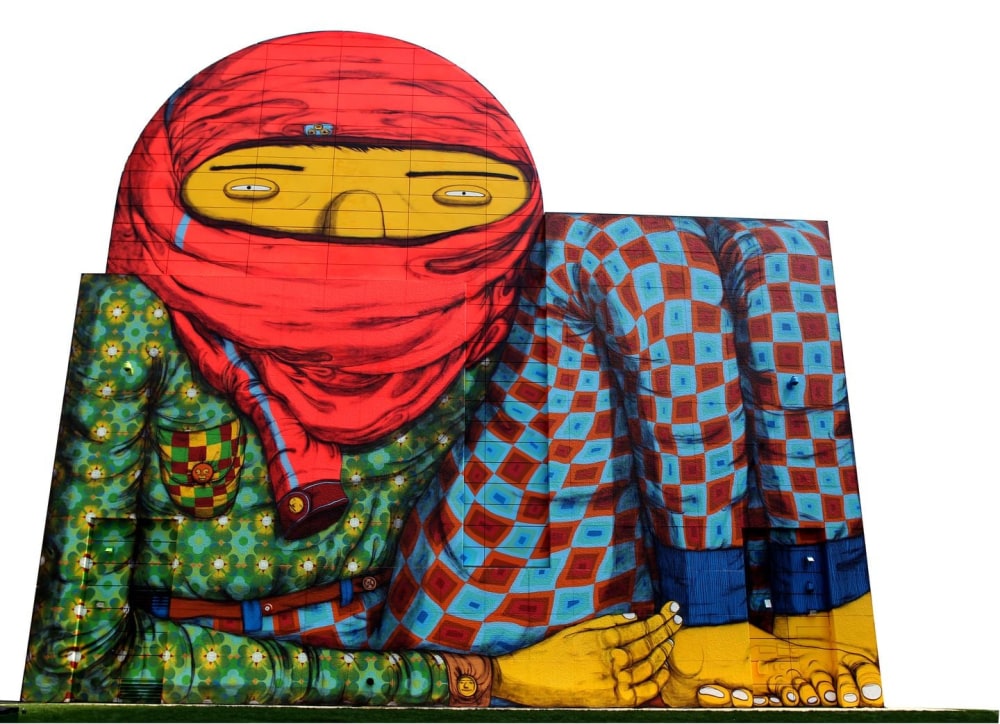
Boston’s once-controversial mural should be saved as a permanent symbol of the city’s edginess and joy
It’s been a year since the Brazilian street-art team of twin brothers Gustavo and Otavio Pandolfo, known as Os Gemeos (“the twins”), in conjunction with their exhibit at the ICA, painted their giant untitled mural in Dewey Square. The piece, part of the Rose F. Kennedy Greenway Conservancy’s program of temporary art installations, is scheduled to come down some time this fall. That’s too bad. This former lightning rod of post-9/11 debate deserves to become a permanent public installation. It has transformed not only an inert architectural structure (the air-intake building over the Route 93 tunnel), but also one of Boston’s most important public spaces, at the crossroads of downtown, the waterfront, and South Station.
Public art is a tricky business — in the open air, unlike a museum or gallery show, art is usually something we see by happenstance rather than choice. At worst, it becomes a blight. At best, we simply stop “seeing” what we don’t like. It becomes part of the unobserved background of our daily lives.
The Os Gemeos mural is not that kind of public art. Measuring 70-by-70 feet, in bright blues and greens and reds, it dominates Dewey Square. It’s not simply that you can't miss it: You must look at it. Aside from the colorful patterning, the depicted figure itself commands the city-scape: a pajama-clad boy, huddled amidst the surrounding towers, peering out at us with eyes masked by a hood.
That hood provoked an evil stew of controversy last year, stoked by the folks at Fox 25. Following a TV segment on the piece, the news station asked on its Facebook page, “What does this look like to you?”, inciting a slew of nasty, racist invective. Even more moderate commentators wondered if a masked figure was the best image to place near the city’s major railway station.
I know the feeling. Back in late April, when I saw a young man downtown wearing a backwards baseball cap, all I could think was: “That kid must be nuts — he looks just like the Marathon bombers.” If clothes can telegraph a message about who we are, this was clearly the wrong one — a poor fashion choice whose expiration date was April 15. Soon enough he’d find out how all those Muslim women dressed in burkas feel.
The thing is, any direct encounter with the Os Gemeos mural belies terrorist associations. The child is clearly wearing a pajama top over his head (one sleeve even hangs down below his chin). What’s more, the posture of the image — crouched, squeezed into the box of the structure — suggests not a threat, but vulnerability. And the colors and patterning are anything but menacing — more like a celebratory shout.
The critical response to the work was near unequivocal. In the Globe, art critic Sebastian Smee called it “by far the most successful piece of public art I’ve seen in Boston in the more than four years I’ve lived here.” Smee went on to praise the piece, with its “delirious patterning and cartoon drawing” as “entirely unexpected and frankly joyous.” In the Boston Phoenix, critic Greg Cook wrote, “It’s the best large-scale public art in Boston in decades.”
The Greenway Conservancy is understandably circumspect about the possibility of the Os Gemeos mural becoming permanent. “Our focus is on temporary public art,” says Charlie McCabe, director of public programs for the Conservancy. The temporary displays follow Boston Art Commission guidelines in accordance with the Massachusetts Department of Transportation, which is the landlord of the Greenway property. The Conservancy’s 2012 five-year plan, which was developed with the assistance of public art consultants and a volunteer group of artists, curators, and funders, reinforced the notion of “temporary public art, working with a variety of artists and ideas.”
It’s true that breaking protocol would make the overall program less dynamic as well as create all manner of bureaucratic headaches — it’s much easier to approve a piece of public art when you know it’s going to be temporary. Still, this is a chance for the city to make a statement about itself and art that can serve as a touchstone for decades to come. And it's not simply a statement that would serve art critics. One need only see the wowed tourists hanging out in Dewey Square, taking photos of the mural, to realize that this piece is sending out another message about Boston. It's not about terrorism, and it’s not the usual Boston tourist references — the Red Sox, Paul Revere, the Freedom Trail. Yes, there's something mysterious about that child, and a bit of a subversive edge in his improvised costuming. Towering over Dewey Square — the site of the Occupy protests of fall 2011 — he says something else about the city: its inclusiveness, its edginess, its capacity for joy.
Photo by Jonathan Wiggs
